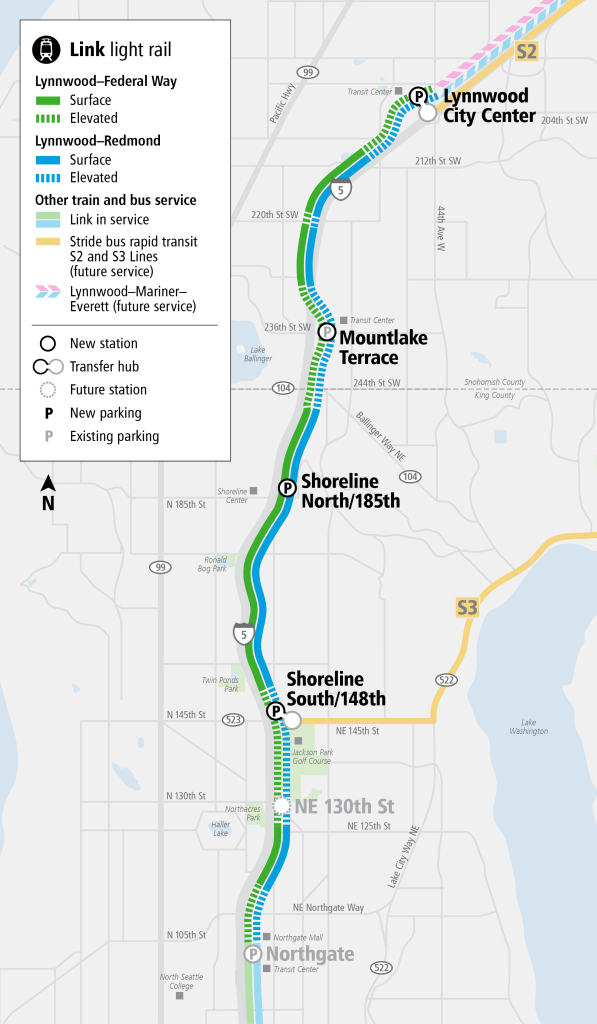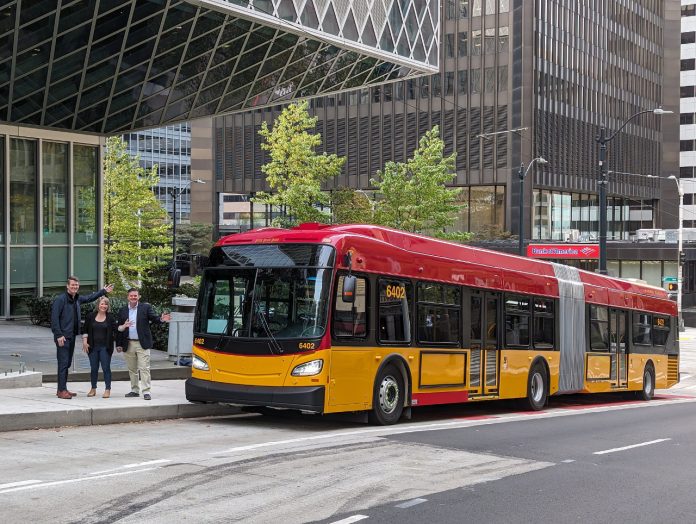
A new Swift line, a RapidRide line, and 12 new light rail stations are all on deck for the coming year.
Public transit enthusiasts and elected officials looking to pose at a ribbon-cutting will have busy calendars in 2024 as brand new transit lines across three different agencies are all set to open next year, setting the stage for a lot of wide-ranging changes that will shift the mobility landscape around the Seattle metro area for years to come. The long awaited-projects, many of which suffered delays and setbacks over the past few years, offer a chance for the region to finally move forward after a holding pattern that things had settled into in 2022 and 2023.
Swift Orange Line
The first new transit line to open in the region next year is likely going to be Community Transit’s Swift Orange Line, with a grand opening currently scheduled for March 30. Running from Edmonds College on the Edmonds/Lynnwood border with McCollum Park and Ride on the Mill Creek/Everett border, the line will provide direct rapid bus service at the front door of the future Lynnwood light rail station, connecting directly to the Swift Green Line in one direction and the Swift Blue Line in the other.
Coming in at $83 million during a time of intense cost escalations on transit projects everywhere, the Orange Line is mostly being funded by federal and state dollars. While the primary value in the line will be the increased frequency of buses, off-board payment and all-door boarding, the project does include some business-access-and-transit (BAT) lanes to speed up buses that might otherwise get stuck in traffic.
“The new line will be about 11 miles long and offer 13 stations or station stop pairs,” The Urbanist’s Stephen Fesler wrote when he previewed the line back in November. “Nineteen platforms for station stops will be provided with all the standard Swift accouterments: transit shelters, off-board ORCA readers, receptacle bins, lighting, real-time arrival information signs, and seating.”
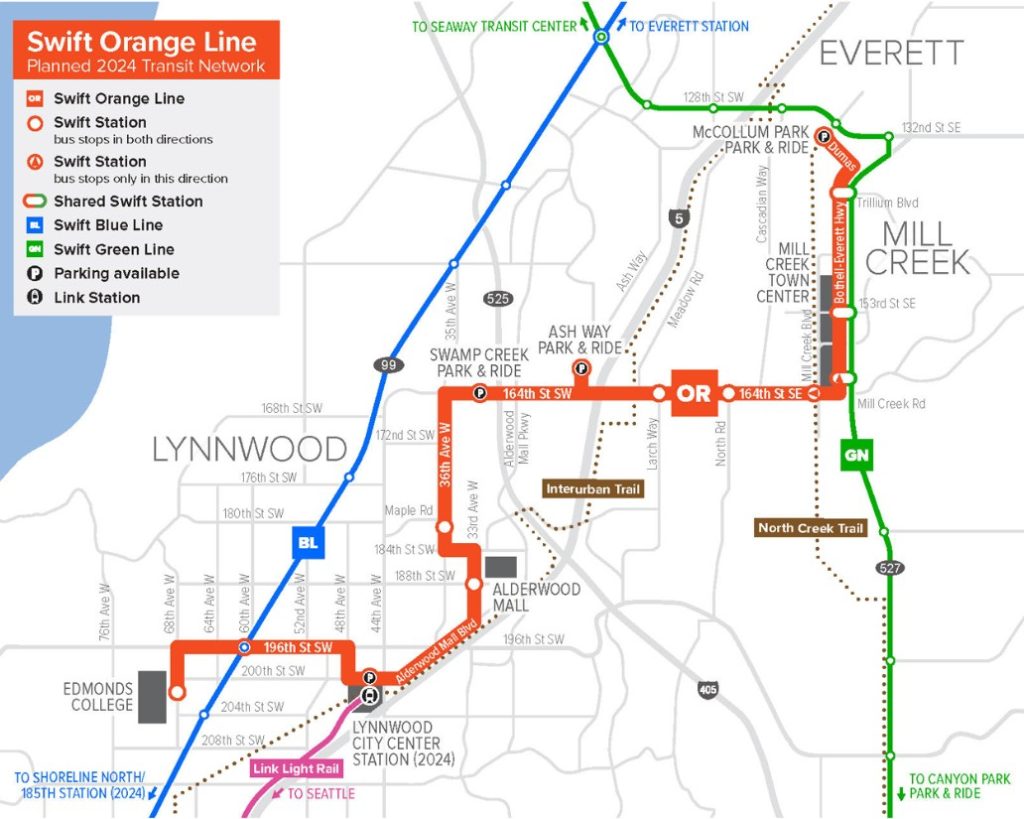
“Community Transit plans to operate the Orange Line with a large span of service and on weekdays regular daytime service will be every 10 to 12 minutes,” Fesler wrote. “During early morning, nights, and on weekends, service will be less frequent as every 15 to 20 minutes.”
Later in the year, Community Transit will connect the Blue Line, which currently terminates at Aurora transit center in Shoreline, to the 185th Street Station in Shoreline, providing another direct connection to light rail.
East Link Starter Line brings partial service on Link 2 Line
Sometime in the spring, Sound Transit expects to start service between eight light rail stations in Bellevue and Redmond that are part of the planned 2 Line, with full service across the lake into Seattle and up to Lynnwood planned to start later, in 2025. The entire 2 Line was originally set to open in 2023, but contractor errors constructing the rail infrastructure across the I-90 bridge have added considerable time — and expense — to the $4 billion transit project.
The exact date for the launch of service isn’t yet known, with about a month’s notice expected ahead of the big day.
Partial service might not have started without strong support from transit advocates on the Eastside, backed up by a strong advocate on the Sound Transit board: King County Councilmember Claudia Balducci. “This concept of opening up a portion of our light rail system that is disconnected from the rest of the light rail system for a period of time is unusual,” Balducci said as Sound Transit’s rider experience committee approved moving forward with the proposal earlier this year. “Unfortunately, this is nobody’s first choice, certainly not mine … but our choices are to wait for a significant and possibly as yet still uncommitted period of time until the bridge opens, or to put to use the very significant and really great infrastructure that has been built in east King County.”
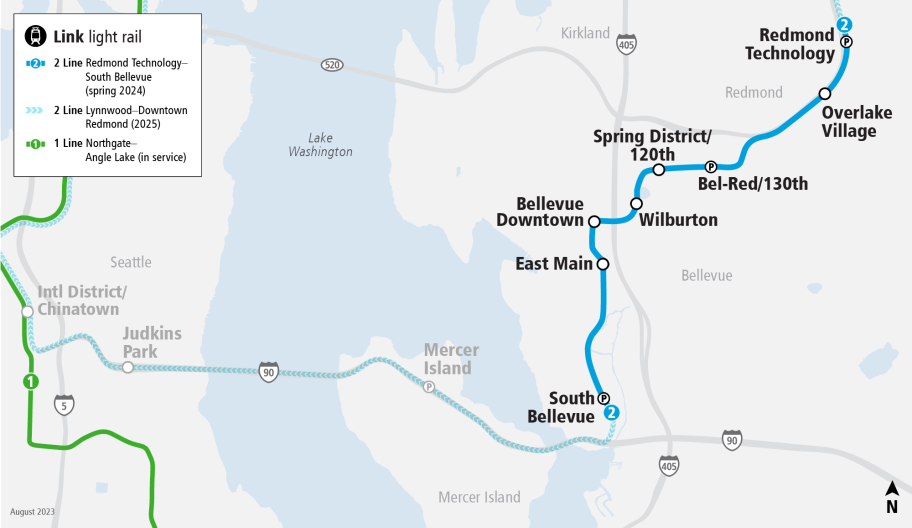
Service along the line will consist of two-car trains to accommodate lower ridership than is expected from the full 2 Line, operating for 16 hours per day, or from approximately 6am to 10pm. Until the full 2 Line opens, Sound Transit will continue to operate express bus service between Seattle and the Eastside connecting to the abbreviated 2 Line. Riders can catch a 550 to South Bellevue station or a 545 to Redmond Technology Center from downtown Seattle, or a 542 from the University District to Redmond. Other changes to bus routes planned for the Eastside will also be delayed to 2025.
East Link’s start of service also coincides with a number of pedestrian and bicycle access improvements along the route, from the new Eastrail bridge over NE 8th Street in Bellevue, to a pedestrian and bike bridge over SR 520 at Overlake Village Station in Redmond, to the massive Microsoft-funded covered overpass connecting to Redmond Technology Center Station that provides a direct connection between the 520 Trail and the light rail station.

RapidRide G Line
Set for next fall is King County Metro’s eighth RapidRide frequent bus line, the G Line. The closest to gold-standard bus rapid transit that Metro has tried to implement, the $130 million project will connect downtown Seattle with First Hill, Capitol Hill, and Madison Valley with very frequent buses throughout most of the day — every six minutes between 6am and 7pm.
After 7pm and on Sundays, service levels will drop to every 15 minutes, not quite hitting the mark of an all-day network.
With the exception of the Madison Valley segment of the route and a few blocks downtown, the G Line will operate in its own dedicated right-of-way, with center-running bus lanes on First Hill that will keep buses fully separated from turning vehicles. Riders will enter and exit buses along this stretch on median islands in the middle of the street, and new 5-door diesel buses (not trolleys) sourced from New Flyer will allow boarding from either side, depending on the stop.
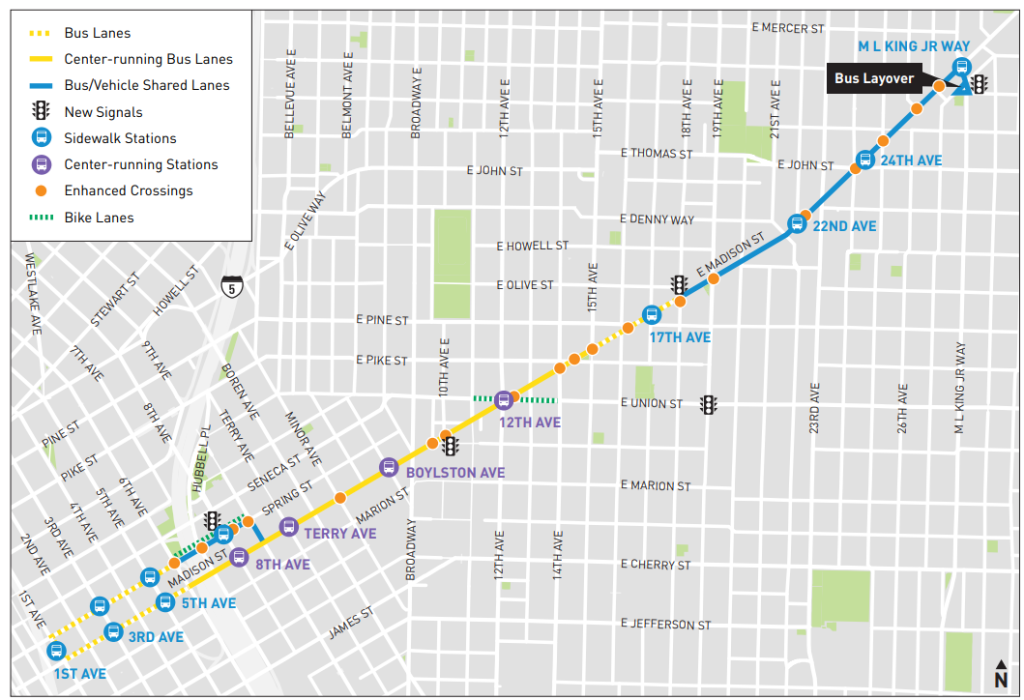
We’ve been covering this bus corridor project for a long time: The first story in The Urbanist on the G Line, originally referred to as Madison BRT, was in fall of 2014. Construction, which finally began in 2021 and has been a long slog as crews completed a full rebuild of the entire corridor, replacing aging water and sewer infrastructure and adding brand new signal equipment to many intersections. Its opening will finally wrap up that work and allow the city to utilize this new link in the city’s frequent transit network.
RapidRide G will also come with a bus network restructure for other routes around Capitol Hill, and the high frequencies on the route are set to come at the expense of some of the local feeder routes in the neighborhood. Metro still hasn’t decided whether Route 47, a longstanding trolley route that serves the Summit Slope neighborhood, will get the ax with the launch of the new bus network, but either way, there’s likely to be a reduction in service on routes like the 49 and the 10. Originally rerouted to serve Capitol Hill light rail station in 2016, the 10 is set to be routed away, but bizarrely not to a corridor that connects to the RapidRide G either. The new network will likely take some getting used to.
Lynnwood Link
Expected in close proximity to the launch of RapidRide G will be the second set of new Sound Transit openings in 2024. Four new stations north of Northgate that make up Lynnwood Link will add service into Snohomish County, with stations in Shoreline at both 148th Street and 185th Street, in Mountlake Terrace, and in Lynnwood. This expansion has been long anticipated but isn’t expected to come without some growing pains.
Due to the shortage of train storage space, until light rail service across I-90 opens up access to the new train maintenance facility in Bellevue, Sound Transit will have a shortage of train capacity to meet expected demand on the 1 Line between Angle Lake and Lynnwood, particularly north of Downtown Seattle where ridership is expected to increase the most. Sound Transit is still considering ways to mitigate this, with express service to Seattle likely to remain in place on certain bus routes.
Two new round trips on the Sounder N Line also planned for next year could lighten some of the load by offering another peak-only way to get to Downtown Seattle.
Lynnwood Link’s launch will also set in motion a slew of changes to bus routes throughout north King County and south Snohomish County. King County Metro’s service change in response to the new stations is set to create some beneficial connections to light rail creating a new frequent network in Shoreline for the new residents who will call the city home, thanks to the zoning changes that Shoreline had made around its light rail stations.
For Community Transit, the launch of Lynnwood Link is a chance to reclaim a significant number of service hours that are currently spent serving Seattle and reinvest them locally in Snohomish County. Bus service on the peak-only network would expand significantly at the same time that frequencies are increased throughout the day on core routes to the county’s biggest destinations. The agency is on track for an all-day frequent network, but in the meantime, places like Stanwood, Lake Stevens, and Marysville will see more bus service that connects to light rail during peak hours.

The launches next year will be hard-earned, but the region still has a long way to go before the investments are leveraged to their full potential.
Ryan Packer has been writing for The Urbanist since 2015, and currently reports full-time as Contributing Editor. Their beats are transportation, land use, public space, traffic safety, and obscure community meetings. Packer has also reported for other regional outlets including Capitol Hill Seattle, BikePortland, Seattle Met, and PubliCola. They live in the Capitol Hill neighborhood of Seattle.


